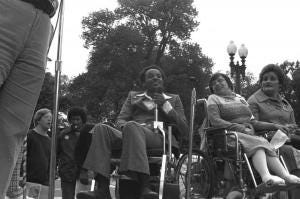We Don't Have to Reinvent Everything
One of the more surprising and fun writing opportunities I had last year was writing for the podcast History Daily. I’ve learned a lot about writing and random history in the process. While sometimes the history I learn is deeply depressing, I often find myself inspired by the stories I learn.
One example comes from the episode I wrote on the Americans with Disabilities Act. The Americans with Disabilities Act was finally signed into law in 1990 after decades of activism from people with disabilities. One of those pivotal actions took place in 1977, and it was called the 504 sit-in. The story of the sit-in is also detailed in the beautiful documentary Crip Camp.
The 504 sit-in was an effort by disability justice activists to force the Department of Human and Welfare (HEW) to enforce regulations that were part of section 504 of the 1973 Rehabilitation Act. Without enforcement, people with disabilities were still discriminated against and practically excluded from public life. Over a hundred people with disabilities ended up occupying the HEW building in San Francisco and other locations. Almost immediately, the building’s water and telephone lines were cut off, but the activists refused to give up. They found a way to take care of everyone, despite the wide range of needs in their community.
One key moment was when Brad Lomax, a Black man with multiple sclerosis, contacted his comrades in the Black Panther Party. They supplied the sit-in activists with food for the remainder of the occupation. This allowed the San Francisco sit-in to become the longest peaceful occupation of a government building in U.S. history. Meanwhile, the activists also had to find ways to make decisions through consensus. This was especially difficult because there were multiple means of communication in the community.

Another example comes from the original Woodstock. I did not realize before researching this episode that Woodstock was a total disaster. The organizers did not plan for the half a million people who arrived. There were not enough food, water, or bathrooms. The crowd also got drenched with rain.
Nonetheless, the situation could have been much worse. In fact, it was common for musical festivals at the time to erupt in riots over much lesser issues. But thanks to the efforts of a collective called the Hog Farm and an outpouring of support from the surrounding community, the festival remained peaceful. I personally doubt that the relatively conservative upstate N.Y. community would have rushed to the aid of the Woodstock crowd if they were not mostly White college students. Still, the fact remains that regular people were able to provide assistance and prevented a more profound catastrophe in the process.
When I reflect on these stories, it reminds me that many of the tools we need for collective liberation already exist. As daunting as it feels to dismantle the many interlocking systems of oppression in our world, it’s helpful to remember that we don’t have to create a whole new world from nothing. We really just have to find ways to look out for each other and provide for each other’s basic needs.
The simple motto that underpins mutual aid efforts like free fridges is “give what you can, take what you need.” This is essentially how the 504 sit-in activists outlasted a showdown with the U.S. government and how Woodstock was able to keep 500,000 concertgoers from starving.
Often times people who argue against abolition or even “lesser” leftist ideas make it seem like the choice in front of us is incremental change to the status quo or all-out chaos. I understand why some might think this when leftists talk about “burning it all down” and building anew. But totally dismantling the institutions we have doesn’t mean we’re starting from scratch. We already have countless stories from history to draw from.
I also want to note that some of the clearest and most exciting examples of mutual aid and transformative justice I know of still come from the disability justice movement. This is a community that knows better than practically anyone how to build radically inclusive spaces.
Whether looking to history or to present-day activists, it’s worth keeping in mind that we don’t have to reinvent everything to build a better world.
Like what you read? Subscribe to my substack to have more content delivered straight to your email.

Comments